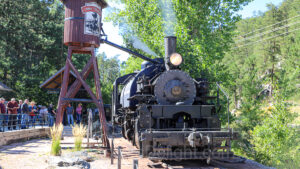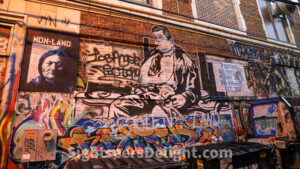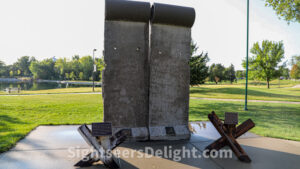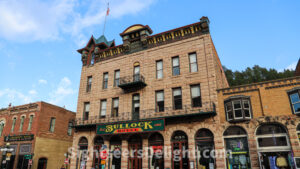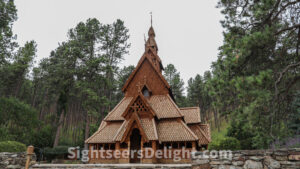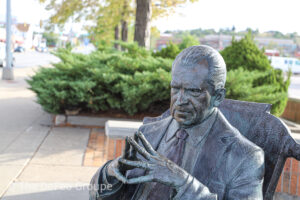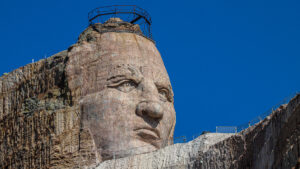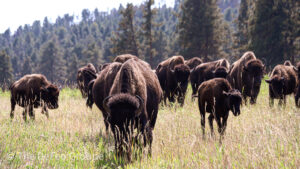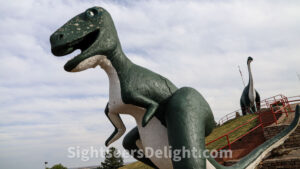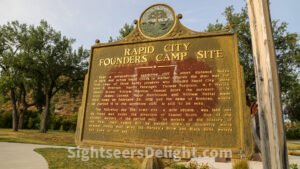The Black Hills Central Railroad operates the 1880 Train between Hill City, South Dakota, and Keystone, South Dakota, on the Burlington Northern Railroad’s former Keystone Branch. The Chicago, Burlington and Quincy Railroad built the line to serve mining and timber interests, reaching Keystone on January 20, 1900. The line later hauled carving equipment for Mount Rushmore. The Black Hills Central acquired the 10-mile-long in 1981. In 1986 Burlington Northern abandoned the Deadwood branch between Hill City and Deadwood.
57745
The Rapid City alley between Main and St. Joseph streets and connecting 6th and 7th streets isn’t some sort of tribute to New York City of the 1970s and 1980s. Instead, Art Alley is a place where established, burgeoning and wannabe artists put up their best work. Artists can procure a permit to paint on buildings’ walls along the alley, making it an ever-changing public art display.
The Berlin Wall exhibit in Memorial Park was installed in 1996. It was originally part of a traveling Berlin Wall exhibit that visited the South Dakota School of Mines and Technology campus. The exhibit features two panels of the wall along with two tank traps. It is surrounded by informative plaques detailing the history of the Berlin Wall.
The Bullock Hotel is a historic landmark located at the corner of Wall Street and Main Street in Deadwood, South Dakota. It was built by Seth Bullock and his business partner Sol Star around 1895 for $40,000. The hotel is the oldest in Deadwood and has 28 of its original 63 rooms and a casino and restaurant. Seth Bullock began construction on the hotel shortly after the devastating Deadwood fire of 1894, which destroyed the original two-story wood-frame building. The hotel was designed in an “Italianate” and Victorian style, with the first floor featuring a grand hotel lobby, a large dining room, and several offices. The second and third stories held 63 luxury sleeping rooms with baths down the halls and two large banks of skylights for natural lighting. All rooms were furnished with iron and brass beds and oak furnishings.
57732
The Chapel in the Hills, a prominent Rapid City landmark, replicates the famous Borgund Stave Church in Norway, dating to the 12th century. The Rapid City chapel was built in 1969 as a tribute to the early Norwegian settlers in the region. The chapel replicates the traditional Norse stave architecture, characterized by vertical wooden posts and intricate woodcarvings. It is made entirely of wood and features a turf roof. The chapel’s interior features intricate woodcarvings that adorn the walls and ceilings, and its design reflects the rich cultural heritage of the Norwegian people. The chapel holds regular church services and often hosts weddings, concerts and other special events.
The City of Presidents in downtown Rapid City is a collection of life-sized bronze statues representing each former American President. More than 40 bronze President statues, sculpted by six different artists, are located on the street corners of Rapid City.
Crazy Horse Memorial in Custer County, South Dakota, is a monument currently being constructed on privately held Black Hills land. The monument depicts Oglala Lakota warrior Crazy Horse on a horse, pointing to his tribal land. Henry Standing Bear, a Lakota elder, commissioned the memorial, selecting Polish-American sculptor Korczak Ziolkowski to create it. The nonprofit Crazy Horse Memorial Foundation operates the monument. Work on the monument began in 1948 and is still far from completion. If the monument is completed as designed, it will be the world’s second tallest statue, following the Statue of Unity in India.
Custer State Park includes more than 71,000 acres and is South Dakota’s first and largest state park. The state park and wildlife reserve is home to an assortment of animals, including free-roaming bison and prairie dogs. The park, established in 1912 and named for Lt. Col. George Armstrong Custer, is famous for Needles Highway and its wildlife loop, offering incredible views of a bison herd and prairie dog towns. In the 1930s, the Civilian Conservation Corps built roads and laid out campgrounds
57730
In the 1930s, work began on Rapid City’s quirky and beloved Dinosaur Park. The idea originated after dinosaur bones and footprints were found in the area. The goal was to convince travelers to Mount Rushmore to visit Rapid City, hoping to change the area from a pass-through town to a must-stop destination. Sculptor Emmet Sullivan and his team used metal pipe frames, wire and concrete to build dinosaurs. Many workers who helped carve Mount Rushmore were hired for the project. Officials initially selected five dinosaurs, but the group expanded to seven when two smaller dinosaurs were added near the gift shop. In the 1950s, the dinosaurs, originally painted gray, were given their green and white color scheme.
The 60-acre Founders Park sits on the site where the original “founders” of Rapid City camped in 1876. Most of the land, which serves as a trailhead for paths along Rapid Creek, was acquired following the 1972 Flood.
57701

